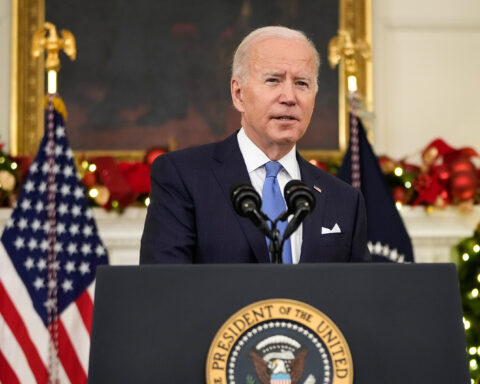Although 2020 was rough for most companies — to say the least — some bucked the trend.
The pandemic forced consumers to learn, workout, socialize and more in new ways. That boosted businesses using technology to improve remote access to their services, and condensed years’ worth of digital adoption into several months.
Those business models could have staying power when the pandemic ends.
“I think the habits that we have all formed over the past 12 months … are not going to go away,” said Jake Matthews, a senior intelligence analyst at CB Insights covering fitness technology.
A lot is riding on the idea that people will keep choosing digital services as life returns to normal. Digital health, education technology and fitness technology startups, for example, raised record amounts of capital in 2020 — raking in a combined $41.4 billion in funding, according to CB Insights.
In some cases, Wall Street has started betting against companies that flourished last year: both Peloton and Zoom toppled from their highs in recent months.
Still, some strong performers from last year say they have an edge over in-person competitors now, and plenty of opportunity remains.
HelloFresh
Meal delivery service HelloFresh was just coming off a blockbuster quarter in which it added over a million new customers when the pandemic hit last year. Instead of the usual tempering of sales growth in the second quarter, HelloFresh’s orders surged.
“There were lots of new customers flocking to our business,” USA CEO Uwe Voss told CNN Business, adding that existing customers also started ordering more frequently.
The pandemic created the perfect conditions for consumers to try HelloFresh, which mails customers meal kits with recipes and precisely measured ingredients. Meal delivery was attractive as many shoppers were avoiding physical grocery stores and cooking novices could easily pick up a new hobby. Plus HelloFresh meals typically cost less than restaurant take-out.
Before the pandemic, the company had expected sales to grow as much as 27% in 2020. Instead, HelloFresh ended the year with total sales up 107% after selling more than 601 million meals. Its shares are up 303% since January 2020.
HelloFresh added 7,000 employees last year and three new US distribution centers to manage the growth.
The company expects sales to normalize in 2021 as the pandemic subsides but still projects revenue growth between 35% and 45%, on top of last year’s surge.
“Even after the pandemic, [it’s still] more affordable than going to a restaurant or getting takeout,” Voss said. “The food tasted good during the pandemic and it will taste good after the pandemic. It’s still a convenient way for you to do dinner.”
To improve its value proposition, HelloFresh is expanding the number of meal kit options from its current roughly 25 choices per week. It launched also a “marketplace” this year, where customers can add sides or snacks to their meal orders.
In November, HelloFresh acquired ready-to-eat meal company Factor75, so its customers can order meals that can be ready in minutes, in addition to the ones they have to prepare. Voss said the new offering appeals to different demographics — “more male households, more single households” — which will help with customer acquisition.
“We believe it’s a very opportunity-rich space for us, and we can do a lot ourselves to create demand in the future,” Voss said.
Tonal
While gyms and fitness studios were among the pandemic’s biggest losers, at-home workout alternatives were clear winners.
Peloton’s sales doubled and stocks gained 420% last year. And Tonal, an at-home strength training system, says its unit sales increased by a whopping 800% in 2020.
When the pandemic hit, “the at-home fitness category really took off in a boom,” Tonal Chief Marketing Officer Chris Stadler said.
Tonal is a flatscreen TV-sized device with extendable, arm-like components that use electricity to create up to 200 pounds of resistance. It costs $2,995, including an accessory pack, with a $49 monthly subscription fee that covers all members of a household. Customers can take classes taught by live instructors, or do workouts designed by an AI “personal assistant.”
The company’s fans include professional athletes: More than half of the NBA teams in last year’s “bubble” used Tonal devices to train. Serena Williams and Mike Tyson are among the company’s investors (last month, Tonal announced a new $250 million funding round).
Even as gyms reopen, Stadler expects many people to remain permanent converts to at-home workouts.
“I think people are seeing results more than [with] any other fitness activity” thanks to the AI personal assistant, Stadler said, adding that customers appreciate the convenience of exercising from home. More than two thirds of consumers who started using a virtual fitness program during the pandemic plan to keep using it long-term, CB Insights’ Matthews said.
In March, Tonal opened 40 “mini shops” inside Nordstrom stores, nearly quadrupling its physical distribution points so more people can try the devices.
The company also wants to replicate the social aspect of belonging to a gym. It launched a “partner workout” feature that lets users work out together, both in-person and virtually.
“As more people start using Tonal, friends and family talk about it, [we expect] referrals will really increase,” Stadler said.
Skillshare
The same collective boredom that led to society’s “Tiger King” obsession also pushed many consumers to find new forms of entertainment. That was a boon to online learning platforms like Skillshare, where subscribers can watch video lessons on everything from animation to marketing.
Skillshare’s daily new users “took a heavy tilt in the right direction” in mid-March 2020 as Covid-19 spread, CEO Matt Cooper said. By June, the company reached its customer acquisition goal for the entire year.
“Everybody ran out of Netflix,” Cooper said. “I think it was: ‘What can I do to get my mind off of what’s going on in the world at large?’ Or, ‘Hey, now’s a great time to invest in that thing I always wanted to learn.'”
In late February of 2020, Skillshare kicked off a funding round that ended up totaling $71 million when it closed last summer — raising more than the company had initially planned to manage the unexpected growth.
As the pandemic wore on, SkillShare noticed changes in the content users engaged with. Although the platform’s top performing videos typically focused on painting, photography and other fine arts, there was growing interest in mental wellbeing and anxiety relief. The company leaned in— shifting its messaging to highlight those offerings.
Skillshare now has more than 13 million members and thousands of teachers making videos. While its explosive growth may moderate post-pandemic, Cooper doesn’t expect it to stop.
The online learning market is set to grow from $200 billion in 2019 to $375 billion by 2026, according to research firm Global Market Insights.
“We’re all eager to get out to restaurants and bars and trips and hotels, so I fully expect that we’ll see some of the engagement slow,” Cooper said. “But I think there have been fundamental changes that have occurred.”
Skillshare’s 135-person team plans to remain fully remote even after the pandemic — a big cost savings and a testament to the permanent evolution.
“Of course we’re going to start doing things in person again, but I don’t think we’re going to leave [behind] a lot of the benefits that we saw from going fully virtual, fully distributed and fully online,” Cooper said.
Nurx
As fear about the spread of Covid-19 set in last spring, many people tried out virtual healthcare (or “telehealth”) for the first time. That included services like Nurx, a platform where patients can connect with medical providers to receive prescriptions for birth control and other treatment.
Demand for Nurx’s services skyrocketed — order volume for emergency contraception, birth control, sexually transmitted infection tests grew 40%, 50% and 100%, respectively. Its total sales climbed 80% year-over-year in 2020, according to CEO Varsha Rao.
Thanks to the pandemic, “there’s more willingness and interest in adopting telehealth for all kinds of services,” Rao said.
As the world reopens, Nurx won’t just be competing with in-person medical providers — the digital healthcare space has also gotten more crowded in the past year. Even Amazon plans to expand its telehealth service.
Nurx is adding new offerings to ensure continued growth. Since September, the company has launched treatment for migraines and acne and plans to add at least three more new services this year.
“Patients are seeking care for important issues for them, but are often hard to access,” Rao said of Nurx’s 325,000 monthly customers. “There’s a shortage of dermatologists, there’s a shortage of neurologists, so these are areas where we can offer very high-quality care.”
In May, Nurx raised $22.5 million in a Series C funding round to help fund the new offerings.
The company also expects consumers to keep choosing the convenience of telehealth over resuming all doctor visits in-person. Experts agree — by 2023, virtual medical visits are expected to exceed face-to-face appointments, according to Gartner research.
“The great thing is that telehealth has moved from being a second or third option for people to being a primary way that they want to seek out care,” Rao said.





